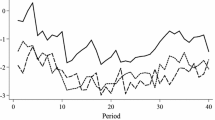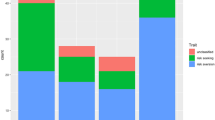Abstract
This paper analyzes whether social comparison can explain the low take-up of disaster insurance usually reported in field studies. We argue that risks in the case of disasters are highly correlated between subjects whereas risks for which high insurance take-up can be observed (e.g. extended warranties or cell phone insurance) are typically idiosyncratic. We set up a simple model with social reference points and show that in the presence of inequality aversion social comparison makes insurance indeed less attractive if risks are correlated. In addition we conducted a simple experiment which confirms these theoretical results. The average willingness to pay for insurance is significantly higher for idiosyncratic than for correlated risks.
Similar content being viewed by others
References
Bault, N., Coricelli, G., & Rustichini, A. (2008). Interdependent utilities: how social ranking affects choice behavior. PLoS ONE, 3(10), e3477. doi:10.1371/journal.pone.0003477.
Browne, M. J., & Hoyt, R. E. (2000). The demand for flood insurance: empirical evidence. Journal of Risk and Uncertainty, 20, 291–306.
Buunk, P., & Gibbons, F. X. (2007). Social comparison: the end of a theory and the emergence of a field. Organizational Behavior and Human Decision Processes, 102, 3–21.
Camerer, C., & Kunreuther, H. (1989). Decision processes for low probability events: policy implications. Journal of Policy Analysis and Management, 4, 565–592.
Camerer, C., & Thaler, R. (1995). Ultimatums, dictators, and manners. Journal of Economic Perspectives, 9, 209–219.
Camerer, C., & Weber, M. (1992). Recent developments in modeling preferences: uncertainty and ambiguity. Journal of Risk and Uncertainty, 5, 325–370.
Ellsberg, D. (1961). Risk, ambiguity, and the Savage axioms. The Quarterly Journal of Economics, 75, 643–669.
Fehr, E., & Schmidt, K. M. (1999). Theory of fairness, competition, and cooperation. The Quarterly Journal of Economics, 114, 817–868.
Fehr, E., & Schmidt, K. M. (2006). The economics of fairness, reciprocity, and altruism—Experimental evidence and new theories. In S. C. Kolm & J. M. Ythier (Eds.), Handbook of the economics of giving, altruism and reciprocity, vol. 1 (pp. 615–691). North-Holland: Elsevier.
Fox, C. R., & Tversky, A. (1995). Ambiguity aversion and comparative ignorance. The Quarterly Journal of Economics, 110, 585–603.
Ganderton, P., Brookshire, D., McKee, M., Stewart, S., & Thurston, H. (2000). Buying insurance for disaster-type risks: experimental evidence. Journal of Risk and Uncertainty, 20, 271–289.
Gill, D., & Prowse, V. (2012). A structural analysis of disappointment aversion in a real effort competition. American Economic Review, 102, 469–503.
Gneezy, U., & Potters, J. (1997). Experiment on risk taking and evaluating periods. Quarterly Journal of Economics, 112, 631–646.
Kahneman, D., & Tversky, A. (1979). Prospect theory: an analysis of decision under risk. Econometrica, 47, 263–291.
Köszegi, B., & Rabin, M. (2006). A model of reference-dependent preferences. Quarterly Journal of Economics, 121, 1133–1165.
Kunreuther, H., & Pauly, M. (2004). Neglecting disaster: why don’t people insure against large losses? Journal of Risk and Uncertainty, 28, 5–21.
Kunreuther, H., Ginsberg, R., Miller, L., Sagi, P., Slovic, P., & Borkan, B. (1978). Disaster insurance protection: Public policy lessons. New York: Wiley.
Laury, S. K., McInnes, M. M., & Swarthout, J. T. (2009). Insurance decisions for low-probability losses. Journal of Risk and Uncertainty, 39, 17–44.
Linde, J., & Sonnemans, J. (2012). Social comparison and risky choices. Journal of Risk and Uncertainty, 44, 45–72.
Loewenstein, G. F., & Adler, D. (1995). A bias in the prediction of tastes. The Economic Journal, 105, 929–937.
McClelland, G. H., Schulze, W. D., & Coursey, D. L. (1993). Insurance for low-probability hazards: a bimodal response to unlikely events. Journal of Risk and Uncertainty, 7, 95–116.
Odean, T. (1998). Are investors reluctant to realize their losses? Journal of Finance, 53, 1775–1798.
Rabin, M. (2000). Risk aversion and expected utility theory: a calibration theorem. Econometrica, 68, 1281–1292.
Rohde, I., & Rohde, K. (2011). Risk attitudes in a social context. Journal of Risk and Uncertainty, 43, 205–225.
Samuelson, W., & Zeckhauser, R. (1988). Status quo bias in decision making. Journal of Risk and Uncertainty, 1, 7–59.
Schlesinger, H. (1997). Insurance demand without the expected-utility paradigm. Journal of Risk and Insurance, 64, 19–39.
Schmidt, U. (2014). Insurance demand under prospect theory: a graphical analysis. Journal of Risk and Insurance, forthcoming. (in press)
Schmidt, U., Starmer, C., & Sugden, R. (2008). Third-generation prospect theory. Journal of Risk and Uncertainty, 36, 203–223.
Shamay-Tsoory, S. G., Tibi-Elhanany, Y., & Aharon-Peretz, J. (2007). The green-eyed monster and malicious joy: the neuroanatomical bases of envy and gloating (schadenfreude). Brain—A Journal of Neurology, 130, 1663–1678.
Slovic, P., Fischhoff, B., Lichtenstein, S., Corrigan, B., & Combs, B. (1977). Preferences for insuring against probable small losses: insurance implications. Journal of Risk and Insurance, 44, 237–257.
Starmer, C. (2000). Developments in non-expected utility theory: the hunt for a descriptive theory of choice under risk. Journal of Economic Literature, 38, 332–382.
Sugden, R. (2003). Reference-dependent subjective expected utility. Journal of Economic Theory, 111, 172–191.
Sydnor, J. (2010). (Over)insuring modest risks. American Economic Journal: Applied Economics, 2, 177–199.
Trautmann, S.T., & van de Kuilen, G. (2014). Ambiguity attitudes. Forthcoming in The Blackwell Handbook of Judgment and Decision Making. (in press)
Trautmann, S., & Vieider, F. M. (2012). Social influences on risk attitudes: Applications in economics. In S. Roeser, R. Hillerbrand, P. Sandin, & M. Peterson (Eds.), Handbook of risk theory (pp. 575–600). Heidelberg: Springer Verlag.
Trautmann, S., Vieider, F. M., & Wakker, P. (2011). Preference reversals for ambiguity aversion. Management Science, 57, 1320–1333.
Tversky, A., & Kahneman, D. (1992). Advances in prospect theory: cumulative representation of uncertainty. Journal of Risk and Uncertainty, 5, 297–323.
Vendrik, M. C. M., & Woltjer, G. B. (2007). Happiness and loss aversion: is utility concave or convex in relative income? Journal of Public Economics, 91, 1423–1448.
Wills, T. A. (1981). Downward comparison principles in social psychology. Psychological Bulletin, 90, 245–271.
Acknowledgments
We would like to thank Nicolas Treich, Stefan Trautmann and Ulrike Doerr for their helpful comments and Ute Vanini for her support in the execution of the experiment.
Author information
Authors and Affiliations
Corresponding author
Rights and permissions
About this article
Cite this article
Friedl, A., Lima de Miranda, K. & Schmidt, U. Insurance demand and social comparison: An experimental analysis. J Risk Uncertain 48, 97–109 (2014). https://doi.org/10.1007/s11166-014-9189-9
Published:
Issue Date:
DOI: https://doi.org/10.1007/s11166-014-9189-9




